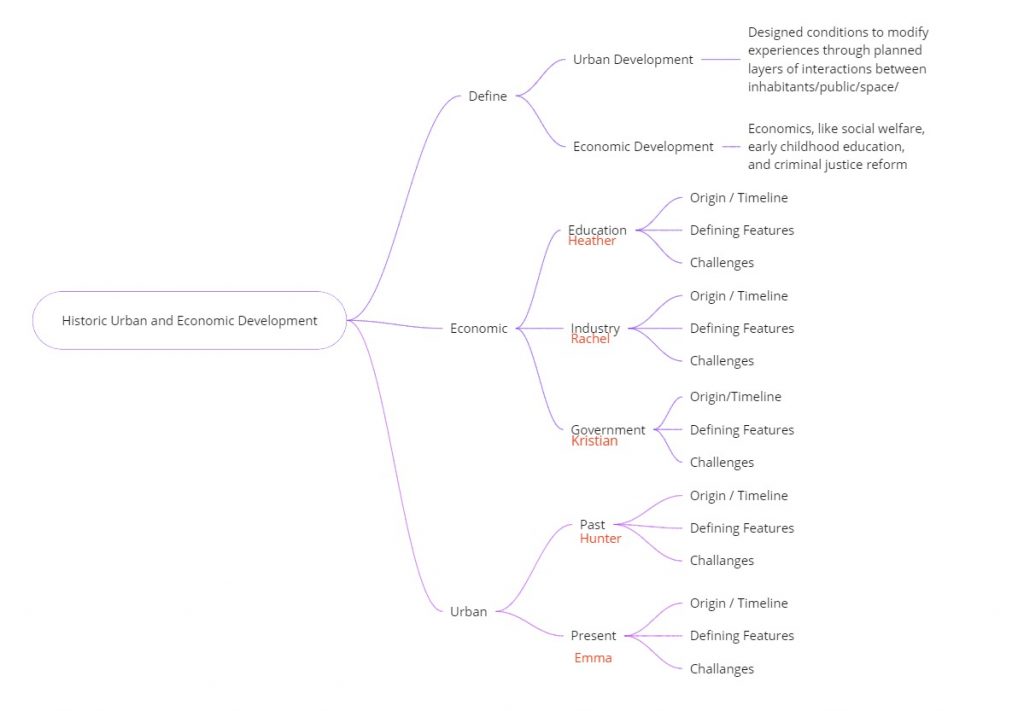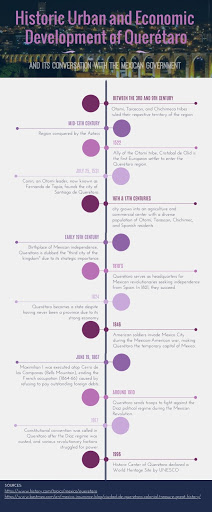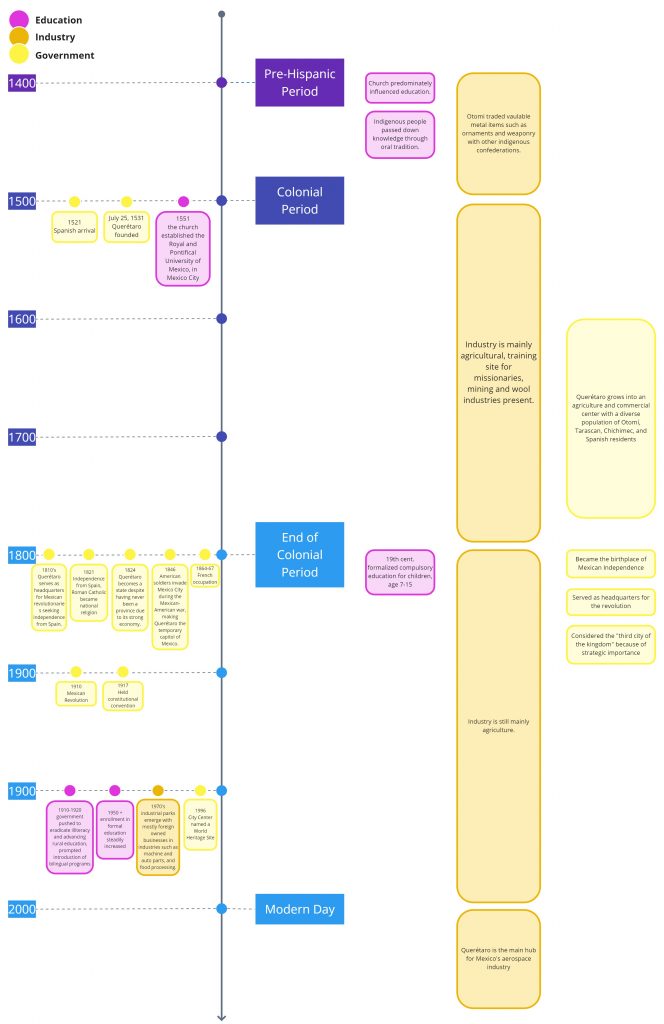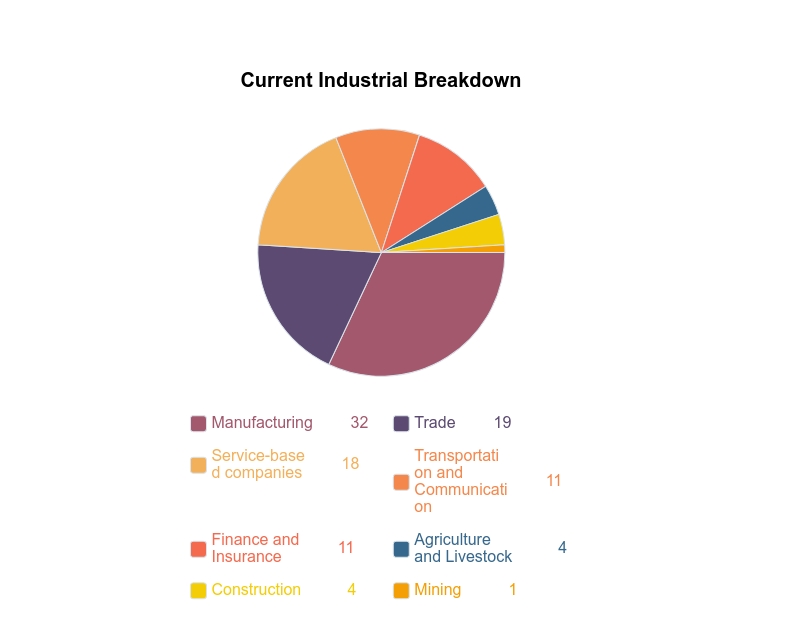Expert Inquiry on the Historic & Economic Development of Queretaro
Throughout week 1, we were asked to develop an Expert Inquiry in regards to the city of Querétaro. Expert inquiries are quick, broad wiki-like investigations into Querétaro from experts in the field. Beginning with surface level research, we start to gain a better understanding of the Historic and Economic Development of the city (Team 1). Other teams focused their research on the Built and Natural Infrastructure of Querétaro (Team 2), Urban Housing (Team 3), and Health and Social Services (Team 4). The goal of writing these inquiries is to better understand the functionality and systematic infrastructure of the area with an emphasis on culture. We asked ourselves ‘what are some of the old and new rituals?’ If we are going to change the story, as designers, we need to have a glimpse into the key aspects of Querétaro’s urban life. The end product from the first three weeks of studio will be to craft a design competition proposal that relates to our specific research subject.
Mind Map
Before starting our research, Team 1 decided to devise a “Mind Map”. This strategy enabled us to sort out our thoughts and divide up research amongst our group members. We broke down our research subject, Historic Urban & Economic Development of Querétaro, into 5 main categories: Economic Education, Economic Industry, Economic Government, Past Urbanism and Present Urbanism.

Introduction Research
Define
Urban Development:
- Designed conditions to modify experiences through planned layers of interactions between inhabitants/public/space/ [class notes]
- Economic Development – like social welfare, early childhood education, and criminal justice reform [3]
- Federal, state, and local governments used to improve standard living through the creation of jobs, the support of innovation and new ideas, the creation of higher wealth, and the creation of an overall better quality of life [4]
Defining Features of Industrial Complexes [1]:
- Metal goods
- Machinery
- Chemicals
- Processed foods
Urban Sprawl Challenges:
- Individual control over small parcels of land
- Unique environmental sites
- Housing affordability [2] – standard issues that might or might not apply
Economic | Education
Heather’s Research
Origin / Timeline:
- Education was historically influenced by the Catholic church [5]
- Most indigenous people learned through oral tradition [5]
- In 1551 the church established the first university in North America, the Royal and Pontifical University of Mexico, in Mexico City [5]
- During the 19th century there was compulsory education for children ages 7-15 [5]
- Between 1910 and 1920 (Mexican Revolution) the government started pushing to eradicate illiteracy and began to advance rural education. This prompted the introduction of bilingual programs in recent decades [5]
- Between 1950 and 2018, enrollments in formal education increased [5]
Defining Features:
- The illiteracy rate in Querétaro (2018) is now around 3% [5]
- The state is now home to Mexico’s only purely aeronautical university [6]
- The ability to design, produce, and assemble these products has significantly benefited the economy
- For the governor of Querétaro, Mexico’s cooperation with the United States in education underscores the importance of recognizing and seizing joint potential [6]
Challenges:
- “Improving Mexico’s education system is critical for addressing pressing problems like high unemployment rates among Mexican youths, who are unemployed at twice the rate of the overall working age population” [5]
- Choosing Spanish as the language of instruction, for instance, resulted in high illiteracy and desertion rates among indigenous peoples [5]
Economic | Industry
Rachel’s Research
Origin / Timeline:
- Pre-Hispanic Period, 1400s – Otomi people were blacksmiths. Traded valuable metal items with other indigenous confederations, like ornaments and weaponry [7]
- Colonial Period, 1500s – Mainly agriculture, training sites for missionaries, mining and wool [8]
- Modern Day – Before 1970s, industry was mainly agricultural. After 1970s, more became industrial parks – mostly foreign owned for machine and auto parts, food processing, paper products, printing, chemicals, glass, aerospace, nanotechnology [9]
Defining Features:
- Querétaro is main hub for Mexico’s aerospace industry [10][11]
- Presence in nanotechnology industry [11]
- Middle class city in terms of PPP GDP. with $20,000 [12]
- Economic growth above national average due to investment in infrastructure, public services, parks, sports, and cultural facilities [13]
- Industries spurs immigration to the city, population growth of 3.5% per year [13]
- Tourism grown due to Querétaro being considered one of the safest to live with highest quality of life in Mexico [13]
Challenges:
- Housing hard to find in centro [13]
- Migrants from poorer areas of Mexico are unemployed or underemployed – led to explosion of informal markets and other businesses in and around the city
Economic | Government
Kristian’s Research
Origin / Timeline:
- 16th/17th Centuries – Grew and matured as an agricultural and commercial center [1]
- 1521 – Spanish arrival [1]
- 1522 to 1526 – Querétaro region where Otomi Indians leader converted to Roman Catholicism to display loyalty to Spaniards
- 17th/18th Centuries – 1736 Santiago de Querétaro aqueduct completed
- 19th Century – Birthplace of Mexican independence, began planning rebellion [1]. Spanish considered it the “third city of the kingdom,” after Mexico City and Puebla due to strategic importance [1]. Served as headquarters for the revolutionaries [1]
- 1821 – Independence from Spain, Roman Catholicism become national religion [1]
- 1824 – Became a state because of strong economy [1]
- 1846 to 1848 – Mexican American War, became temporary capital of Mexico [1]
- 1864 to 1866 – France occupied because of foreign debt [1]
- 20th Century – 1910 Mexican Revolution: Querétaro sent forces to fight the governments and in 1917, constitutional convention called in Querétaro [1]
- Today – 32% of economy is manufacturing

Urbanism | Past
Hunter’s Research
Origin / Timeline:
- 17th / 18th Century – Wealth of outstanding buildings, nobility developed, a lot still existing [15]
Defining Features:
- It was the site of many historic battles [14]
- Home to famous Mexican dignitaries [14]
- Was the nation’s capital on three separate occasions [14]
- Tie past and present through restored cathedral [14]
- Elements – Plazas, open spaces such as the Alameda, neighborhoods, civil and religious construction [15]
- Multi-ethnic population – Otomi, Tarasco, Chichimec, Spanish [15]
- Layout that reflects the coexistence of different groups in the same urban space [15]
- Exceptional example of a Spanish colonial town whose layout symbolizes its multiethnic population [15]
- Two distinct sections in town plan – One rectilinear and intended for Spanish settlers, the other composed of smaller, winding streets where the indigenous population lived [15]
- Retained the geometric street plan of the Spanish conquerors side-by-side with the twisting alleys of the Indian quarters [15]
- The south-east had to be crossed in order to reach the capital of New Spain [15]
- The boundary between the southern lands, gradually settled by the Spaniards [15]
- Northern region, which was under the control of hostile nomad peoples such as the Chichimecas [15]
Challenges:
- Interaction of multi-ethnic population
- Historic conflicts

Urbanism | Present
Emma’s Research
Origin / Timeline:
- Was transformed from rural-to-urban [16]
- “A modern city with a well-preserved colonial past” [16]
- “Querétaro was saved through poverty. At a time when the rest of Mexico was modernizing, the town was trapped in a recession; once the industry returned, its leaders were determined to maintain what years of paucity had preserved.” [16]
- Old World ambiance
Defining Features:
- Miles of low-rise, medium-density sprawl after growth spurt in 1985 [16]
- All the housing is one type, except for the far edges [16]
- Both lower and middle class citizens live here [16]
- Middle and higher class citizens tend to favor American-style, single-use gated communities and move farther out from the city center [16]
- Retained the geometric street plan, while twisting alleys of the Indian quarters surrounds [16]
- Ordinance enables compact, walkable urbanism found in Centro Historico: an area less than 20 sq. blocks [16]
- Short, walkable blocks are key to the cities success [16]
- Thorough mixed-use is essential [16]
- There are attractive destinations [16]
- Constant upkeep: there is not litter and very little graffiti [16]
- Beauty of the plazas and churches and other architecture is important to modern attraction, but so is its culture of public life, centered around both the church and the local marketplace [16]
- Very little privacy
- Many pedestrian only streets, almost too many one-way streets
- One-way streets prevent speedways (clogged with people) [16]
- Town is mixed used, nearly every other doorway opens to a business, little shop, courtyard café, government or professional office [16]
Challenges:
- Integration and relation to existing, historic urbanism [16]
- Old urbanism breaks many of the cardinal rules of the new urbanism [16]
- Sidewalks are too narrow for comfortable walking, there is no mitigating factor [16]
Combined Timeline
We compiled our research into a timeline which covers the important historic events, as early as the 1400’s pre-historic era, up until present day. These influential events have significantly shaped Querétaro into the city that stands today. A few major historic events that greatly impacted the city of Querétaro include: the Colonial Period when Querétaro was founded in 1531, the End of the Colonial Period in the 1800’s, as well as the Mexican Revolution in 1910. Around the 19th century, a formalized, bilingual education system was initiated to help advance rural communities. Throughout most of Querétaro’s history, agriculture remained the main source of industry until more industrial parks begin to emerge. These mostly foreign owned businesses broke into industries such as: machine and auto parts, and food processing in the 1970’s.

Industrial Breakdown
The pie chart below helps to visualize the breakdown of Querétaro’s current industrial standing. Manufacturing and trade of agricultural resources remain high, while mining plays only a small part in the overall industrial breakdown.

Conclusion
The city of Querétaro faced many challenges in the past, and continues to face new challenges with modern urbanism. The biggest challenge for the city today is integration and relation to existing, historic infrastructure. Much of the old urban structures break the cardinal rules of new building development. In the past, Querétaro advanced through periods of poverty. However, in later years when Mexico was modernizing, this town was trapped in a recession. Once the industry returned, the city had been transformed from rural-to-urban within a matter of years. Historic preservation and continuous maintenance are essential for the old world ambiance to live on.
Sources
[1] https://www.history.com/topics/mexico/queretaro
[2] https://www.ierek.com/news/index.php/2017/01/17/urban-planning-definition-problems-and-solutions/
[3] https://denversouthedp.org/what-is-economic-development/
[4] https://study.com/academy/lesson/what-is-economic-development-definition-examples.html
[5] https://wenr.wes.org/2019/05/education-in-mexico-2
[6] https://clas.berkeley.edu/research/mexico-quer%C3%A9taro-approach
[7] Chapter 11, pp. 231 to 254 in Alan R. Sandstrom and E. Hugo García Valencía, eds. Native Peoples of the Gulf Coast of Mexico. Tucson: University of Arizona Press
[8] QUERETARO IN THE HISTORY OF MEXICO. (1966). Artes De México, (84/85), 20-21. Retrieved May 21, 2020, from www.jstor.org/stable/24312727
[9] https://www.investinqueretaro.com/
[11] Luna-Ochoa, Sergio Marco A., Eduardo Robles-Belmont, and Ernesto Suaste-Gomez. “A Profile of Mexico’s Technological Agglomerations: The Case of the Aerospace and Nanotechnology Industry in Queretaro and Monterrey.” Technology in Society 46 (2016): 120-125. Web.
[12] OECD.Stat
[13] https://internationalliving.com/countries/mexico/queretaro-mexico/
[13] https://internationalliving.com/countries/mexico/queretaro-mexico/
[14] https://www.gonomad.com/3569-queretaro-mexico-living-breathing-history
[15] https://whc.unesco.org/en/list/792/
[16]http://www.tndtownpaper.com/Volume8/centro_historico_de_queretaro.htm